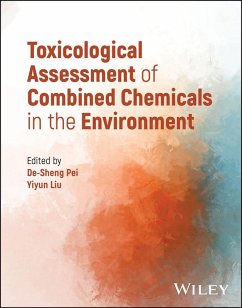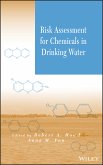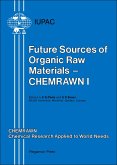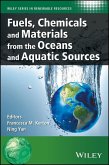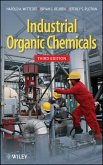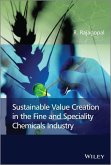Toxicological Assessment of Combined Chemicals in the Environment (eBook, PDF)
Redaktion: Pei, De-Sheng; Liu, Yiyun
190,99 €
190,99 €
inkl. MwSt.
Sofort per Download lieferbar

0 °P sammeln
190,99 €
Als Download kaufen

190,99 €
inkl. MwSt.
Sofort per Download lieferbar

0 °P sammeln
Jetzt verschenken
Alle Infos zum eBook verschenken
190,99 €
inkl. MwSt.
Sofort per Download lieferbar
Alle Infos zum eBook verschenken

0 °P sammeln
Toxicological Assessment of Combined Chemicals in the Environment (eBook, PDF)
Redaktion: Pei, De-Sheng; Liu, Yiyun
- Format: PDF
- Merkliste
- Auf die Merkliste
- Bewerten Bewerten
- Teilen
- Produkt teilen
- Produkterinnerung
- Produkterinnerung

Bitte loggen Sie sich zunächst in Ihr Kundenkonto ein oder registrieren Sie sich bei
bücher.de, um das eBook-Abo tolino select nutzen zu können.
Hier können Sie sich einloggen
Hier können Sie sich einloggen
Sie sind bereits eingeloggt. Klicken Sie auf 2. tolino select Abo, um fortzufahren.

Bitte loggen Sie sich zunächst in Ihr Kundenkonto ein oder registrieren Sie sich bei bücher.de, um das eBook-Abo tolino select nutzen zu können.
Comprehensive resource covering toxicology fundamentals, distribution of pollutants in the environment, and research methodologies for toxicological assessment of chemical mixtures
Toxicological Assessment of Combined Chemicals in the Environment offers an in-depth exploration of various approaches and molecular mechanisms regarding how minor alterations in chemical mixtures can influence an organism's toxicity, along with discussion of the challenges associated with assessing mixtures.
The first section of the book provides a concise introduction to the background and significance of…mehr
- Geräte: PC
- mit Kopierschutz
- eBook Hilfe
- Größe: 10.13MB
Andere Kunden interessierten sich auch für
![Risk Assessment for Chemicals in Drinking Water (eBook, PDF) Risk Assessment for Chemicals in Drinking Water (eBook, PDF)]() Robert A. HowdRisk Assessment for Chemicals in Drinking Water (eBook, PDF)141,99 €
Robert A. HowdRisk Assessment for Chemicals in Drinking Water (eBook, PDF)141,99 €![Future Sources of Organic Raw Materials: CHEMRAWN I (eBook, PDF) Future Sources of Organic Raw Materials: CHEMRAWN I (eBook, PDF)]() Future Sources of Organic Raw Materials: CHEMRAWN I (eBook, PDF)52,95 €
Future Sources of Organic Raw Materials: CHEMRAWN I (eBook, PDF)52,95 €![Fuels, Chemicals and Materials from the Oceans and Aquatic Sources (eBook, PDF) Fuels, Chemicals and Materials from the Oceans and Aquatic Sources (eBook, PDF)]() Fuels, Chemicals and Materials from the Oceans and Aquatic Sources (eBook, PDF)116,99 €
Fuels, Chemicals and Materials from the Oceans and Aquatic Sources (eBook, PDF)116,99 €![Industrial Organic Chemicals (eBook, PDF) Industrial Organic Chemicals (eBook, PDF)]() Harold A. WittcoffIndustrial Organic Chemicals (eBook, PDF)147,99 €
Harold A. WittcoffIndustrial Organic Chemicals (eBook, PDF)147,99 €![Destruction of Hazardous Chemicals in the Laboratory (eBook, PDF) Destruction of Hazardous Chemicals in the Laboratory (eBook, PDF)]() George LunnDestruction of Hazardous Chemicals in the Laboratory (eBook, PDF)150,99 €
George LunnDestruction of Hazardous Chemicals in the Laboratory (eBook, PDF)150,99 €![Sustainable Value Creation in the Fine and Speciality Chemicals Industry (eBook, PDF) Sustainable Value Creation in the Fine and Speciality Chemicals Industry (eBook, PDF)]() R. RajagopalSustainable Value Creation in the Fine and Speciality Chemicals Industry (eBook, PDF)103,99 €
R. RajagopalSustainable Value Creation in the Fine and Speciality Chemicals Industry (eBook, PDF)103,99 €![Manufacture of Fine Chemicals from Acetylene (eBook, PDF) Manufacture of Fine Chemicals from Acetylene (eBook, PDF)]() Sifang LiManufacture of Fine Chemicals from Acetylene (eBook, PDF)169,95 €
Sifang LiManufacture of Fine Chemicals from Acetylene (eBook, PDF)169,95 €-
-
-
Comprehensive resource covering toxicology fundamentals, distribution of pollutants in the environment, and research methodologies for toxicological assessment of chemical mixtures
Toxicological Assessment of Combined Chemicals in the Environment offers an in-depth exploration of various approaches and molecular mechanisms regarding how minor alterations in chemical mixtures can influence an organism's toxicity, along with discussion of the challenges associated with assessing mixtures.
The first section of the book provides a concise introduction to the background and significance of combined toxicity. Section two delves into the primary sources and enrichment mechanisms of different chemical mixtures, elucidating the biological exposure pathways of these compounds. Section three introduces both classical and emerging toxicological research models in detail. Building on the descriptions of compound emission, migration, accumulation, and transformation processes, and the analysis of combined molecular toxicity in the preceding sections, section four introduces computer mathematical modeling methods for hazard assessment of compound mixtures. The final section details the challenges and future trends in this field.
Written by a highly qualified author and seasoned research contributor in the field, Toxicological Assessment of Combined Chemicals in the Environment covers sample topics including:
Toxicological Assessment of Combined Chemicals in the Environment serves as a valuable reference for researchers, students, and policymakers involved in environmental management and protection. It is particularly relevant for toxicologists, risk assessors, and those engaged in the molecular modeling of toxic mixtures.
Toxicological Assessment of Combined Chemicals in the Environment offers an in-depth exploration of various approaches and molecular mechanisms regarding how minor alterations in chemical mixtures can influence an organism's toxicity, along with discussion of the challenges associated with assessing mixtures.
The first section of the book provides a concise introduction to the background and significance of combined toxicity. Section two delves into the primary sources and enrichment mechanisms of different chemical mixtures, elucidating the biological exposure pathways of these compounds. Section three introduces both classical and emerging toxicological research models in detail. Building on the descriptions of compound emission, migration, accumulation, and transformation processes, and the analysis of combined molecular toxicity in the preceding sections, section four introduces computer mathematical modeling methods for hazard assessment of compound mixtures. The final section details the challenges and future trends in this field.
Written by a highly qualified author and seasoned research contributor in the field, Toxicological Assessment of Combined Chemicals in the Environment covers sample topics including:
- The degradation, oxidation, absorption, distribution, biotransformation, and excretion of various compounds in both the environment and in organisms
- A variety of cell models and in vivo research models of model organisms, supplemented with case studies
- Combined molecular toxicity mechanisms of heavy metals, pesticides, persistent organic pollutants (POPs), and pharmaceutical and personal care products (PPCPs)
- Principal sources, fate, and mechanism of chemical mixtures in the environment, as well as experimental designs and sampling strategies for combined toxicity studies based on concentrations
Toxicological Assessment of Combined Chemicals in the Environment serves as a valuable reference for researchers, students, and policymakers involved in environmental management and protection. It is particularly relevant for toxicologists, risk assessors, and those engaged in the molecular modeling of toxic mixtures.
Dieser Download kann aus rechtlichen Gründen nur mit Rechnungsadresse in D ausgeliefert werden.
Produktdetails
- Produktdetails
- Verlag: Wiley
- Seitenzahl: 413
- Erscheinungstermin: 14. Januar 2025
- Englisch
- ISBN-13: 9781394158331
- Artikelnr.: 72854458
- Verlag: Wiley
- Seitenzahl: 413
- Erscheinungstermin: 14. Januar 2025
- Englisch
- ISBN-13: 9781394158331
- Artikelnr.: 72854458
- Herstellerkennzeichnung Die Herstellerinformationen sind derzeit nicht verfügbar.
De-Sheng Pei, PhD, Professor & Doctoral Supervisor, School of Public Health, Chongqing Medical University. He is currently engaged in research on animal disease models, germ-free fish models, toxicological effects of environmental pollutants, and molecular mechanisms of disease caused by environmental pollutants. His discoveries have been published in more than 180 research papers. Yiyun Liu, PhD, School of Public Health, Chongqing Medical University. In 2022, Dr. Liu graduated from the Research Center for Eco-Environmental Science (RCEES), Chinese Academy of Sciences.
FOREWORD
Preface
DEDICATION
ACKNOWLEDGMENTS
List of Contributors
Chapter 1 Introduction to combined toxicology, background, key
terminologies, and significance
1.1 Background
1.2 Key Terminologies
1.3 Significance
Chapter 2 Toxicokinetics of chemical mixture exposure in the environment
2.1 Unveiling Toxicokinetics
2.2 Toxicokinetics and chemical mixture assessment
2.3 List of toxic chemicals/pollutants present in the environment
2.4 Toxicokinetics of selected Organohalides compounds/mixtures
2.5 Conclusion
Chapter 3 Toxicodynamics of chemical mixtures exposure in the organism's
body
3.1 Chemical mixtures in the environment
3.2 Model organism in toxicology
3.3 Toxicodynamics of chemical mixtures
3.4 Conclusion
Chapter 4 Principal sources, fate, and mechanism of chemical mixtures in
the environment
4.1 Microplastic mixtures
4.2 Pesticide mixtures
4.3 Heavy metal and metalloid metal mixtures
4.4 Nanoparticle mixtures
4.5 Persistent organic pollutants (POPs)
4.6 Antibiotic mixtures
Chapter 5 Experimental designs and sampling strategies for combined
toxicity studies based on concentrations
5.1 Introduction
5.2 Need for risk assessment studies
5.3 Risk assessment of mixture toxicity
5.4 Experimental designs and methodologies for mixture toxicity
5.5 Concentration of mixture substances
5.6 Concentration-based strategy
5.7 Ecotoxicity tests: acute (short-term exposure) and chronic test
(long-term exposure)
5.8 Sampling of biomarkers
5.9 Animal models for combined toxicity
5.10 Conclusion
Chapter 6 Migration and transformation of chemical pollutants as mixtures
6.1 Volatile organic compounds
6.2 Polybrominated diphenyl ethers
6.3 Tetrabromobisphenol A and its derivatives
6.4 Per- and polyfluoroalkyl substances
6.5 Organophosphorus flame retardants
6.6 Phthalic acid esters
6.7 Polycyclic aromatic hydrocarbons
6.8 Alkylphenols
6.9 Methylsiloxanes
Chapter 7 Analytical Techniques used to detect chemical mixtures in the
environment
7.1 Introduction
7.2 Navigating the complexities of mixture toxicity: A persistent
challenge in environmental health
7.3 Advancing environmental monitoring: Towards a holistic
understanding of chemical mixtures
7.4 Sample preparation: Enhancing specificity and efficiency in
mixture analysis
7.5 Expanding the analytical toolbox: Emerging extraction
techniques for complex environmental matrices
7.6 Analytical techniques for characterizing organic pollutants:
Advancing beyond traditional approaches
7.7 Outlook: Towards holistic environmental monitoring with
advanced analytical tools
Chapter 8 Common toxicological experimental models
8.1 Male reproductive function
8.2 Female reproductive function
Chapter 9 Combined molecular toxicity mechanism of heavy metals mixtures
9.1 Introduction: Heavy metal exposures were everywhere
9.2 Combined molecular toxicity of heavy metal mixtures in the
cardiovascular system
9.3 Combined molecular toxicity of heavy metal mixtures in the
nervous system
9.4 Combined molecular toxicity of heavy metal mixtures in the male
reproductive system
9.5 Combined molecular toxicity of heavy metal mixtures in the
female reproductive system
9.6 Combined molecular toxicity of heavy metal mixtures in the
liver
9.7 Combined molecular toxicity of heavy metal mixtures in the
immune system
9.8 Combined toxicity of heavy metals mixture in the regulation of
immune mediators
9.9 Combined toxicity of heavy metals mixture in the immune
response to the immunogen
9.10 Combined molecular toxicity of heavy metal mixtures in the
tumorigenesis
9.11 Combined molecular toxicity of heavy metal mixtures in the
Orofacial Clefts
9.12 Combined molecular toxicity of heavy metal mixtures in the
olfactory system
Chapter 10 Combined molecular toxicity mechanism of pesticide mixtures
10.1 Introduction
10.2 Epidemiology of pesticide pollution
10.3 Diseases caused by pesticides
10.4 The combined molecular toxicity mechanisms of pesticide
mixture
10.5 Summary
Chapter 11 Combined molecular toxicity mechanism of persistent organic
pollutant (POP) mixtures
11.1 Introduction
11.2 Design of the components of POP mixtures and their
concentrations
11.3 Developmental toxicity of POP mixtures
11.4 Endocrine effects of POP mixtures
11.5 Molecular toxicity mechanisms of POPs
11.6 Conclusion
Chapter 12 Combined molecular toxicity mechanism of emerging pollutants
(PPCPs) mixtures
12.1 Introduction
12.2 Adverse drug interactions or reactions of pharmaceutical
mixtures
12.3 Mechanistic toxicology of PPCP mixtures
12.4 Conclusions and recommendations for future studies
Chapter 13 Combined Molecular toxicity mechanism of phthalates (PAEs)
mixtures
13.1 Human exposure to phthalates
13.2 PAEs and diseases
13.3 The toxic molecular mechanisms of PAEs mixture
13.4 Conclusion
Chapter 14 Combined Molecular Toxicity Mechanism of Microplastic Mixtures
14.1 Heavy metals
14.2 Persistent organic pollutants
14.3 Pathogens
14.4 Engineered nanomaterials
14.5 Other contaminants
14.6 Conclusion and prospect
Chapter 15 Combined Molecular toxicity mechanism of flame retardant
mixtures
15.1 Introduction
15.2 Synergistic effects of OFRs co-exposure on oxidative stress
and DNA damage
15.3 Synergistic effects of OFRs co-exposure on endocrine
disruption and reproduction toxicity
15.4 Synergistic effects of OFRs co-exposure on neurotoxicity
15.5 Synergistic effects of OFRs co-exposure on immunotoxicity
15.6 Synergistic effects of OFRs co-exposure on growth,
development, and organ
15.7 Antagonism effects of OFRs co-exposure on growth, development,
and organ
15.8 Summary and perspectives
Chapter 16 Adverse outcome pathways (AOPs) of combined pollutants mixtures
and their toxicogenetic endpoints
16.1 Background
16.2 Originated AOP and approaches of research in public databases
16.3 Development Adverse Outcome Pathways (AOPs)
16.4 Pollutants
16.5 Challenges and Future Perspectives
16.6 Conclusion.
Chapter 17 Mathematical Model for Combined Toxicity Prediction
17.1 Introduction
17.2 Fundamental Concepts of Combined Toxicity
17.3 Significance of hazard evaluation for combined chemicals
17.4 Mathematical models for combined toxicity prediction
17.5 Evaluation of model and selection criteria
17.6 Future directions and research needs
17.7 Conclusion
Chapter 18 Novel Quantitative Structure-Activity Relationships (QSARs)
Tox-21 techniques for combined toxicity prediction
18.1 Introduction
18.2 Computational approaches and the policy
18.3 The methods for QSAR models
18.4 Tox21 and ToxCast
18.5 The Cases of QSAR studies for prediction of the toxicity of
chemical mixtures.
18.6 Future Avenues of Chemical Mixture Toxicity Prediction
Research
Chapter 19 Challenges and Prospects in the Application of Experimental,
Analytical, and Predictive Models in Combined Toxicity Assessment
19.1 Introduction
19.2 Experimental models
19.3 Analytical methods
19.4 Mathematical models.
19.5 Challenges and prospects associated with combined toxicity
assessment
19.6 Conclusion
Chapter 20 Future Research Perspectives of Combined Toxicology
20.1 Introduction.
20.2 General terms of toxicological assessment
20.3 Exposure to combined chemicals or mixtures
20.4 Risk exposure assessment
20.5 Limitations in current knowledge of combined chemical exposure
20.6 Data limitations.
20.7 Improvements and future perspectives.
Chapter 21 Combined toxicity of chemicals: Final thoughts and concluding
remark
21.1 Key findings summary of this book
21.2 Final thoughts
21.3 Concluding remarks
..........................................
Preface
DEDICATION
ACKNOWLEDGMENTS
List of Contributors
Chapter 1 Introduction to combined toxicology, background, key
terminologies, and significance
1.1 Background
1.2 Key Terminologies
1.3 Significance
Chapter 2 Toxicokinetics of chemical mixture exposure in the environment
2.1 Unveiling Toxicokinetics
2.2 Toxicokinetics and chemical mixture assessment
2.3 List of toxic chemicals/pollutants present in the environment
2.4 Toxicokinetics of selected Organohalides compounds/mixtures
2.5 Conclusion
Chapter 3 Toxicodynamics of chemical mixtures exposure in the organism's
body
3.1 Chemical mixtures in the environment
3.2 Model organism in toxicology
3.3 Toxicodynamics of chemical mixtures
3.4 Conclusion
Chapter 4 Principal sources, fate, and mechanism of chemical mixtures in
the environment
4.1 Microplastic mixtures
4.2 Pesticide mixtures
4.3 Heavy metal and metalloid metal mixtures
4.4 Nanoparticle mixtures
4.5 Persistent organic pollutants (POPs)
4.6 Antibiotic mixtures
Chapter 5 Experimental designs and sampling strategies for combined
toxicity studies based on concentrations
5.1 Introduction
5.2 Need for risk assessment studies
5.3 Risk assessment of mixture toxicity
5.4 Experimental designs and methodologies for mixture toxicity
5.5 Concentration of mixture substances
5.6 Concentration-based strategy
5.7 Ecotoxicity tests: acute (short-term exposure) and chronic test
(long-term exposure)
5.8 Sampling of biomarkers
5.9 Animal models for combined toxicity
5.10 Conclusion
Chapter 6 Migration and transformation of chemical pollutants as mixtures
6.1 Volatile organic compounds
6.2 Polybrominated diphenyl ethers
6.3 Tetrabromobisphenol A and its derivatives
6.4 Per- and polyfluoroalkyl substances
6.5 Organophosphorus flame retardants
6.6 Phthalic acid esters
6.7 Polycyclic aromatic hydrocarbons
6.8 Alkylphenols
6.9 Methylsiloxanes
Chapter 7 Analytical Techniques used to detect chemical mixtures in the
environment
7.1 Introduction
7.2 Navigating the complexities of mixture toxicity: A persistent
challenge in environmental health
7.3 Advancing environmental monitoring: Towards a holistic
understanding of chemical mixtures
7.4 Sample preparation: Enhancing specificity and efficiency in
mixture analysis
7.5 Expanding the analytical toolbox: Emerging extraction
techniques for complex environmental matrices
7.6 Analytical techniques for characterizing organic pollutants:
Advancing beyond traditional approaches
7.7 Outlook: Towards holistic environmental monitoring with
advanced analytical tools
Chapter 8 Common toxicological experimental models
8.1 Male reproductive function
8.2 Female reproductive function
Chapter 9 Combined molecular toxicity mechanism of heavy metals mixtures
9.1 Introduction: Heavy metal exposures were everywhere
9.2 Combined molecular toxicity of heavy metal mixtures in the
cardiovascular system
9.3 Combined molecular toxicity of heavy metal mixtures in the
nervous system
9.4 Combined molecular toxicity of heavy metal mixtures in the male
reproductive system
9.5 Combined molecular toxicity of heavy metal mixtures in the
female reproductive system
9.6 Combined molecular toxicity of heavy metal mixtures in the
liver
9.7 Combined molecular toxicity of heavy metal mixtures in the
immune system
9.8 Combined toxicity of heavy metals mixture in the regulation of
immune mediators
9.9 Combined toxicity of heavy metals mixture in the immune
response to the immunogen
9.10 Combined molecular toxicity of heavy metal mixtures in the
tumorigenesis
9.11 Combined molecular toxicity of heavy metal mixtures in the
Orofacial Clefts
9.12 Combined molecular toxicity of heavy metal mixtures in the
olfactory system
Chapter 10 Combined molecular toxicity mechanism of pesticide mixtures
10.1 Introduction
10.2 Epidemiology of pesticide pollution
10.3 Diseases caused by pesticides
10.4 The combined molecular toxicity mechanisms of pesticide
mixture
10.5 Summary
Chapter 11 Combined molecular toxicity mechanism of persistent organic
pollutant (POP) mixtures
11.1 Introduction
11.2 Design of the components of POP mixtures and their
concentrations
11.3 Developmental toxicity of POP mixtures
11.4 Endocrine effects of POP mixtures
11.5 Molecular toxicity mechanisms of POPs
11.6 Conclusion
Chapter 12 Combined molecular toxicity mechanism of emerging pollutants
(PPCPs) mixtures
12.1 Introduction
12.2 Adverse drug interactions or reactions of pharmaceutical
mixtures
12.3 Mechanistic toxicology of PPCP mixtures
12.4 Conclusions and recommendations for future studies
Chapter 13 Combined Molecular toxicity mechanism of phthalates (PAEs)
mixtures
13.1 Human exposure to phthalates
13.2 PAEs and diseases
13.3 The toxic molecular mechanisms of PAEs mixture
13.4 Conclusion
Chapter 14 Combined Molecular Toxicity Mechanism of Microplastic Mixtures
14.1 Heavy metals
14.2 Persistent organic pollutants
14.3 Pathogens
14.4 Engineered nanomaterials
14.5 Other contaminants
14.6 Conclusion and prospect
Chapter 15 Combined Molecular toxicity mechanism of flame retardant
mixtures
15.1 Introduction
15.2 Synergistic effects of OFRs co-exposure on oxidative stress
and DNA damage
15.3 Synergistic effects of OFRs co-exposure on endocrine
disruption and reproduction toxicity
15.4 Synergistic effects of OFRs co-exposure on neurotoxicity
15.5 Synergistic effects of OFRs co-exposure on immunotoxicity
15.6 Synergistic effects of OFRs co-exposure on growth,
development, and organ
15.7 Antagonism effects of OFRs co-exposure on growth, development,
and organ
15.8 Summary and perspectives
Chapter 16 Adverse outcome pathways (AOPs) of combined pollutants mixtures
and their toxicogenetic endpoints
16.1 Background
16.2 Originated AOP and approaches of research in public databases
16.3 Development Adverse Outcome Pathways (AOPs)
16.4 Pollutants
16.5 Challenges and Future Perspectives
16.6 Conclusion.
Chapter 17 Mathematical Model for Combined Toxicity Prediction
17.1 Introduction
17.2 Fundamental Concepts of Combined Toxicity
17.3 Significance of hazard evaluation for combined chemicals
17.4 Mathematical models for combined toxicity prediction
17.5 Evaluation of model and selection criteria
17.6 Future directions and research needs
17.7 Conclusion
Chapter 18 Novel Quantitative Structure-Activity Relationships (QSARs)
Tox-21 techniques for combined toxicity prediction
18.1 Introduction
18.2 Computational approaches and the policy
18.3 The methods for QSAR models
18.4 Tox21 and ToxCast
18.5 The Cases of QSAR studies for prediction of the toxicity of
chemical mixtures.
18.6 Future Avenues of Chemical Mixture Toxicity Prediction
Research
Chapter 19 Challenges and Prospects in the Application of Experimental,
Analytical, and Predictive Models in Combined Toxicity Assessment
19.1 Introduction
19.2 Experimental models
19.3 Analytical methods
19.4 Mathematical models.
19.5 Challenges and prospects associated with combined toxicity
assessment
19.6 Conclusion
Chapter 20 Future Research Perspectives of Combined Toxicology
20.1 Introduction.
20.2 General terms of toxicological assessment
20.3 Exposure to combined chemicals or mixtures
20.4 Risk exposure assessment
20.5 Limitations in current knowledge of combined chemical exposure
20.6 Data limitations.
20.7 Improvements and future perspectives.
Chapter 21 Combined toxicity of chemicals: Final thoughts and concluding
remark
21.1 Key findings summary of this book
21.2 Final thoughts
21.3 Concluding remarks
..........................................
FOREWORD
Preface
DEDICATION
ACKNOWLEDGMENTS
List of Contributors
Chapter 1 Introduction to combined toxicology, background, key
terminologies, and significance
1.1 Background
1.2 Key Terminologies
1.3 Significance
Chapter 2 Toxicokinetics of chemical mixture exposure in the environment
2.1 Unveiling Toxicokinetics
2.2 Toxicokinetics and chemical mixture assessment
2.3 List of toxic chemicals/pollutants present in the environment
2.4 Toxicokinetics of selected Organohalides compounds/mixtures
2.5 Conclusion
Chapter 3 Toxicodynamics of chemical mixtures exposure in the organism's
body
3.1 Chemical mixtures in the environment
3.2 Model organism in toxicology
3.3 Toxicodynamics of chemical mixtures
3.4 Conclusion
Chapter 4 Principal sources, fate, and mechanism of chemical mixtures in
the environment
4.1 Microplastic mixtures
4.2 Pesticide mixtures
4.3 Heavy metal and metalloid metal mixtures
4.4 Nanoparticle mixtures
4.5 Persistent organic pollutants (POPs)
4.6 Antibiotic mixtures
Chapter 5 Experimental designs and sampling strategies for combined
toxicity studies based on concentrations
5.1 Introduction
5.2 Need for risk assessment studies
5.3 Risk assessment of mixture toxicity
5.4 Experimental designs and methodologies for mixture toxicity
5.5 Concentration of mixture substances
5.6 Concentration-based strategy
5.7 Ecotoxicity tests: acute (short-term exposure) and chronic test
(long-term exposure)
5.8 Sampling of biomarkers
5.9 Animal models for combined toxicity
5.10 Conclusion
Chapter 6 Migration and transformation of chemical pollutants as mixtures
6.1 Volatile organic compounds
6.2 Polybrominated diphenyl ethers
6.3 Tetrabromobisphenol A and its derivatives
6.4 Per- and polyfluoroalkyl substances
6.5 Organophosphorus flame retardants
6.6 Phthalic acid esters
6.7 Polycyclic aromatic hydrocarbons
6.8 Alkylphenols
6.9 Methylsiloxanes
Chapter 7 Analytical Techniques used to detect chemical mixtures in the
environment
7.1 Introduction
7.2 Navigating the complexities of mixture toxicity: A persistent
challenge in environmental health
7.3 Advancing environmental monitoring: Towards a holistic
understanding of chemical mixtures
7.4 Sample preparation: Enhancing specificity and efficiency in
mixture analysis
7.5 Expanding the analytical toolbox: Emerging extraction
techniques for complex environmental matrices
7.6 Analytical techniques for characterizing organic pollutants:
Advancing beyond traditional approaches
7.7 Outlook: Towards holistic environmental monitoring with
advanced analytical tools
Chapter 8 Common toxicological experimental models
8.1 Male reproductive function
8.2 Female reproductive function
Chapter 9 Combined molecular toxicity mechanism of heavy metals mixtures
9.1 Introduction: Heavy metal exposures were everywhere
9.2 Combined molecular toxicity of heavy metal mixtures in the
cardiovascular system
9.3 Combined molecular toxicity of heavy metal mixtures in the
nervous system
9.4 Combined molecular toxicity of heavy metal mixtures in the male
reproductive system
9.5 Combined molecular toxicity of heavy metal mixtures in the
female reproductive system
9.6 Combined molecular toxicity of heavy metal mixtures in the
liver
9.7 Combined molecular toxicity of heavy metal mixtures in the
immune system
9.8 Combined toxicity of heavy metals mixture in the regulation of
immune mediators
9.9 Combined toxicity of heavy metals mixture in the immune
response to the immunogen
9.10 Combined molecular toxicity of heavy metal mixtures in the
tumorigenesis
9.11 Combined molecular toxicity of heavy metal mixtures in the
Orofacial Clefts
9.12 Combined molecular toxicity of heavy metal mixtures in the
olfactory system
Chapter 10 Combined molecular toxicity mechanism of pesticide mixtures
10.1 Introduction
10.2 Epidemiology of pesticide pollution
10.3 Diseases caused by pesticides
10.4 The combined molecular toxicity mechanisms of pesticide
mixture
10.5 Summary
Chapter 11 Combined molecular toxicity mechanism of persistent organic
pollutant (POP) mixtures
11.1 Introduction
11.2 Design of the components of POP mixtures and their
concentrations
11.3 Developmental toxicity of POP mixtures
11.4 Endocrine effects of POP mixtures
11.5 Molecular toxicity mechanisms of POPs
11.6 Conclusion
Chapter 12 Combined molecular toxicity mechanism of emerging pollutants
(PPCPs) mixtures
12.1 Introduction
12.2 Adverse drug interactions or reactions of pharmaceutical
mixtures
12.3 Mechanistic toxicology of PPCP mixtures
12.4 Conclusions and recommendations for future studies
Chapter 13 Combined Molecular toxicity mechanism of phthalates (PAEs)
mixtures
13.1 Human exposure to phthalates
13.2 PAEs and diseases
13.3 The toxic molecular mechanisms of PAEs mixture
13.4 Conclusion
Chapter 14 Combined Molecular Toxicity Mechanism of Microplastic Mixtures
14.1 Heavy metals
14.2 Persistent organic pollutants
14.3 Pathogens
14.4 Engineered nanomaterials
14.5 Other contaminants
14.6 Conclusion and prospect
Chapter 15 Combined Molecular toxicity mechanism of flame retardant
mixtures
15.1 Introduction
15.2 Synergistic effects of OFRs co-exposure on oxidative stress
and DNA damage
15.3 Synergistic effects of OFRs co-exposure on endocrine
disruption and reproduction toxicity
15.4 Synergistic effects of OFRs co-exposure on neurotoxicity
15.5 Synergistic effects of OFRs co-exposure on immunotoxicity
15.6 Synergistic effects of OFRs co-exposure on growth,
development, and organ
15.7 Antagonism effects of OFRs co-exposure on growth, development,
and organ
15.8 Summary and perspectives
Chapter 16 Adverse outcome pathways (AOPs) of combined pollutants mixtures
and their toxicogenetic endpoints
16.1 Background
16.2 Originated AOP and approaches of research in public databases
16.3 Development Adverse Outcome Pathways (AOPs)
16.4 Pollutants
16.5 Challenges and Future Perspectives
16.6 Conclusion.
Chapter 17 Mathematical Model for Combined Toxicity Prediction
17.1 Introduction
17.2 Fundamental Concepts of Combined Toxicity
17.3 Significance of hazard evaluation for combined chemicals
17.4 Mathematical models for combined toxicity prediction
17.5 Evaluation of model and selection criteria
17.6 Future directions and research needs
17.7 Conclusion
Chapter 18 Novel Quantitative Structure-Activity Relationships (QSARs)
Tox-21 techniques for combined toxicity prediction
18.1 Introduction
18.2 Computational approaches and the policy
18.3 The methods for QSAR models
18.4 Tox21 and ToxCast
18.5 The Cases of QSAR studies for prediction of the toxicity of
chemical mixtures.
18.6 Future Avenues of Chemical Mixture Toxicity Prediction
Research
Chapter 19 Challenges and Prospects in the Application of Experimental,
Analytical, and Predictive Models in Combined Toxicity Assessment
19.1 Introduction
19.2 Experimental models
19.3 Analytical methods
19.4 Mathematical models.
19.5 Challenges and prospects associated with combined toxicity
assessment
19.6 Conclusion
Chapter 20 Future Research Perspectives of Combined Toxicology
20.1 Introduction.
20.2 General terms of toxicological assessment
20.3 Exposure to combined chemicals or mixtures
20.4 Risk exposure assessment
20.5 Limitations in current knowledge of combined chemical exposure
20.6 Data limitations.
20.7 Improvements and future perspectives.
Chapter 21 Combined toxicity of chemicals: Final thoughts and concluding
remark
21.1 Key findings summary of this book
21.2 Final thoughts
21.3 Concluding remarks
..........................................
Preface
DEDICATION
ACKNOWLEDGMENTS
List of Contributors
Chapter 1 Introduction to combined toxicology, background, key
terminologies, and significance
1.1 Background
1.2 Key Terminologies
1.3 Significance
Chapter 2 Toxicokinetics of chemical mixture exposure in the environment
2.1 Unveiling Toxicokinetics
2.2 Toxicokinetics and chemical mixture assessment
2.3 List of toxic chemicals/pollutants present in the environment
2.4 Toxicokinetics of selected Organohalides compounds/mixtures
2.5 Conclusion
Chapter 3 Toxicodynamics of chemical mixtures exposure in the organism's
body
3.1 Chemical mixtures in the environment
3.2 Model organism in toxicology
3.3 Toxicodynamics of chemical mixtures
3.4 Conclusion
Chapter 4 Principal sources, fate, and mechanism of chemical mixtures in
the environment
4.1 Microplastic mixtures
4.2 Pesticide mixtures
4.3 Heavy metal and metalloid metal mixtures
4.4 Nanoparticle mixtures
4.5 Persistent organic pollutants (POPs)
4.6 Antibiotic mixtures
Chapter 5 Experimental designs and sampling strategies for combined
toxicity studies based on concentrations
5.1 Introduction
5.2 Need for risk assessment studies
5.3 Risk assessment of mixture toxicity
5.4 Experimental designs and methodologies for mixture toxicity
5.5 Concentration of mixture substances
5.6 Concentration-based strategy
5.7 Ecotoxicity tests: acute (short-term exposure) and chronic test
(long-term exposure)
5.8 Sampling of biomarkers
5.9 Animal models for combined toxicity
5.10 Conclusion
Chapter 6 Migration and transformation of chemical pollutants as mixtures
6.1 Volatile organic compounds
6.2 Polybrominated diphenyl ethers
6.3 Tetrabromobisphenol A and its derivatives
6.4 Per- and polyfluoroalkyl substances
6.5 Organophosphorus flame retardants
6.6 Phthalic acid esters
6.7 Polycyclic aromatic hydrocarbons
6.8 Alkylphenols
6.9 Methylsiloxanes
Chapter 7 Analytical Techniques used to detect chemical mixtures in the
environment
7.1 Introduction
7.2 Navigating the complexities of mixture toxicity: A persistent
challenge in environmental health
7.3 Advancing environmental monitoring: Towards a holistic
understanding of chemical mixtures
7.4 Sample preparation: Enhancing specificity and efficiency in
mixture analysis
7.5 Expanding the analytical toolbox: Emerging extraction
techniques for complex environmental matrices
7.6 Analytical techniques for characterizing organic pollutants:
Advancing beyond traditional approaches
7.7 Outlook: Towards holistic environmental monitoring with
advanced analytical tools
Chapter 8 Common toxicological experimental models
8.1 Male reproductive function
8.2 Female reproductive function
Chapter 9 Combined molecular toxicity mechanism of heavy metals mixtures
9.1 Introduction: Heavy metal exposures were everywhere
9.2 Combined molecular toxicity of heavy metal mixtures in the
cardiovascular system
9.3 Combined molecular toxicity of heavy metal mixtures in the
nervous system
9.4 Combined molecular toxicity of heavy metal mixtures in the male
reproductive system
9.5 Combined molecular toxicity of heavy metal mixtures in the
female reproductive system
9.6 Combined molecular toxicity of heavy metal mixtures in the
liver
9.7 Combined molecular toxicity of heavy metal mixtures in the
immune system
9.8 Combined toxicity of heavy metals mixture in the regulation of
immune mediators
9.9 Combined toxicity of heavy metals mixture in the immune
response to the immunogen
9.10 Combined molecular toxicity of heavy metal mixtures in the
tumorigenesis
9.11 Combined molecular toxicity of heavy metal mixtures in the
Orofacial Clefts
9.12 Combined molecular toxicity of heavy metal mixtures in the
olfactory system
Chapter 10 Combined molecular toxicity mechanism of pesticide mixtures
10.1 Introduction
10.2 Epidemiology of pesticide pollution
10.3 Diseases caused by pesticides
10.4 The combined molecular toxicity mechanisms of pesticide
mixture
10.5 Summary
Chapter 11 Combined molecular toxicity mechanism of persistent organic
pollutant (POP) mixtures
11.1 Introduction
11.2 Design of the components of POP mixtures and their
concentrations
11.3 Developmental toxicity of POP mixtures
11.4 Endocrine effects of POP mixtures
11.5 Molecular toxicity mechanisms of POPs
11.6 Conclusion
Chapter 12 Combined molecular toxicity mechanism of emerging pollutants
(PPCPs) mixtures
12.1 Introduction
12.2 Adverse drug interactions or reactions of pharmaceutical
mixtures
12.3 Mechanistic toxicology of PPCP mixtures
12.4 Conclusions and recommendations for future studies
Chapter 13 Combined Molecular toxicity mechanism of phthalates (PAEs)
mixtures
13.1 Human exposure to phthalates
13.2 PAEs and diseases
13.3 The toxic molecular mechanisms of PAEs mixture
13.4 Conclusion
Chapter 14 Combined Molecular Toxicity Mechanism of Microplastic Mixtures
14.1 Heavy metals
14.2 Persistent organic pollutants
14.3 Pathogens
14.4 Engineered nanomaterials
14.5 Other contaminants
14.6 Conclusion and prospect
Chapter 15 Combined Molecular toxicity mechanism of flame retardant
mixtures
15.1 Introduction
15.2 Synergistic effects of OFRs co-exposure on oxidative stress
and DNA damage
15.3 Synergistic effects of OFRs co-exposure on endocrine
disruption and reproduction toxicity
15.4 Synergistic effects of OFRs co-exposure on neurotoxicity
15.5 Synergistic effects of OFRs co-exposure on immunotoxicity
15.6 Synergistic effects of OFRs co-exposure on growth,
development, and organ
15.7 Antagonism effects of OFRs co-exposure on growth, development,
and organ
15.8 Summary and perspectives
Chapter 16 Adverse outcome pathways (AOPs) of combined pollutants mixtures
and their toxicogenetic endpoints
16.1 Background
16.2 Originated AOP and approaches of research in public databases
16.3 Development Adverse Outcome Pathways (AOPs)
16.4 Pollutants
16.5 Challenges and Future Perspectives
16.6 Conclusion.
Chapter 17 Mathematical Model for Combined Toxicity Prediction
17.1 Introduction
17.2 Fundamental Concepts of Combined Toxicity
17.3 Significance of hazard evaluation for combined chemicals
17.4 Mathematical models for combined toxicity prediction
17.5 Evaluation of model and selection criteria
17.6 Future directions and research needs
17.7 Conclusion
Chapter 18 Novel Quantitative Structure-Activity Relationships (QSARs)
Tox-21 techniques for combined toxicity prediction
18.1 Introduction
18.2 Computational approaches and the policy
18.3 The methods for QSAR models
18.4 Tox21 and ToxCast
18.5 The Cases of QSAR studies for prediction of the toxicity of
chemical mixtures.
18.6 Future Avenues of Chemical Mixture Toxicity Prediction
Research
Chapter 19 Challenges and Prospects in the Application of Experimental,
Analytical, and Predictive Models in Combined Toxicity Assessment
19.1 Introduction
19.2 Experimental models
19.3 Analytical methods
19.4 Mathematical models.
19.5 Challenges and prospects associated with combined toxicity
assessment
19.6 Conclusion
Chapter 20 Future Research Perspectives of Combined Toxicology
20.1 Introduction.
20.2 General terms of toxicological assessment
20.3 Exposure to combined chemicals or mixtures
20.4 Risk exposure assessment
20.5 Limitations in current knowledge of combined chemical exposure
20.6 Data limitations.
20.7 Improvements and future perspectives.
Chapter 21 Combined toxicity of chemicals: Final thoughts and concluding
remark
21.1 Key findings summary of this book
21.2 Final thoughts
21.3 Concluding remarks
..........................................
